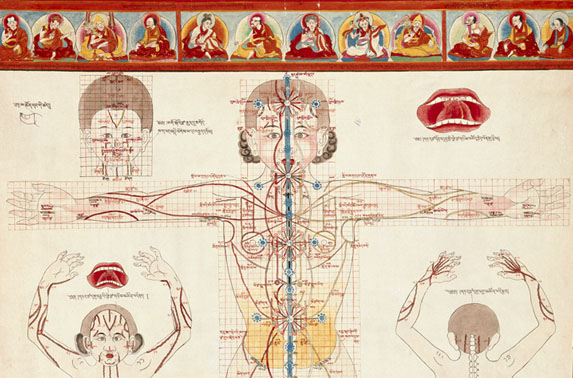Tibetan Medicine & Medical Information
The basic teachings of Tibetan medicine share much with those of other Asian medical traditions, which, according to some scholars, made their way to the East via India from ancient Greece. While the Western medical tradition treats symptoms that indicate a known medical condition (measles or mumps, for example), the Eastern medical tradition looks at symptoms as indications of an imbalance in the body and seeks to restore that balance.
The Tibetan medical tradition is largely textual. It derives from Indian sources and was studied in some monasteries in much the same way that Buddhist scriptures were studied. When Tibetans needed medical help they usually went to a local “apothecary” who sold boncoctions of herbs and blessed pills; equally, help was sought in prayers and good-luck charms.
The theory of Tibetan medicine is based on an extremely complex systm of checks and balances between what can be broadly described as three ‘humours’ (related to state of mind), seven ‘bodily sustainers’ (related to the digestive tract) and three ‘eliminators’ (related to the elimination of bodily wastes). And if the relationship between bodily functions and the three humours of desire, egoism and ignorance were not complex enough, there is the influence of harmful spirits to consider. There are 360 harmful femal influences, 360 harmful male influences, 360 malevolent naga (water spirits) influences stemming from past karma. All these combine to produce 404 basic disorders and 84,000 illnesses!
How does a Tibetan doctor assess the condition of a patient? The most important skill is pulse diagnosis. A Tibetan doctor is attuned to 360 ‘subtle channels’ of energy that run through the body’s skin and muscle, internal organs and bone and marrow. The condition of these channels can be ascertained through six of the doctor’s fingers (the first three fingers of each hand). Tibetan medicine also relies on urine analysis as an important diagnostic tool.
If Tibetan diagnostic theory is mainly Indian in influence, the treatment owes as much to Chinese medicine as to Indian practises. Herbal concoctions, moxibustion and acupuncture are all used to restore balance to the body. Surgery was practised in the early days of Tibetan medicine, but was outlawed in the 9th century when a king’s mother died during an operation.
Yuthok Yongten Gonpo (1182-1251), the physician of King Trisong Detsen, who was born near Ralung Monastery, is credited as the founder of the Tibetan medical system. For more on Tibetan medicine see the website www.tibetan-medicine.org.
If you get sick during your tour in Tibet, you can get a diagnosis from Lhasa’s Mentsikhang (Traiditional Tibetan Hospital; 9.30am-12.30am & 3.30pm-6pm) opposite the Barkhor. Two English-speaking doctors attend to foreigners on the 3rd floor.





















